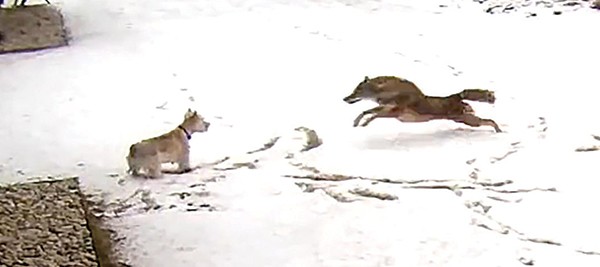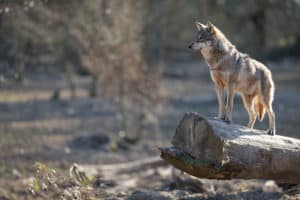
Can you kill a coyote with an airgun? My co-workers didn’t think so, but they were wrong.
Guys, I’ve got a Coyote problem I’ve been trying to solve. Recalling a conversation with a friend in the market for an airgun I asked myself, “Is an airgun the answer to my problems?” The answer is a definite yes, if I get the right one. What one though? I didn’t need a crazy setup. I needed something that wouldn’t break the bank, but would get the job done. It had to be powerful enough to do the job, but quiet enough not to bother the neighbors. If you’ve got a similar problem follow me through my own solution.
Some backstory
I was recently at my cabin in northern Minnesota and heard a bunch of coyotes attacking another animal. The coyotes seemed to be in a frenzy, barking, howling and snarling; it caused me some concern. Since I have two small dogs, I am worried that they may become easy prey. It made me wonder if I could do something about it, either trap them or shoot them. My only concern is that they only seem to be active at night. So, the noise from a rifle may upset my neighbors as well as shooting high-powered rifles that close to other houses and cabins.
Some Questions I Asked Myself
I already said I found an Air Rifle to be the solution I wanted. With that question out of the way, I dove into the research. I needed to know why I was shooting the coyotes, the proper caliber for the task at hand, what’s the optimal distance, and what other tips might make me more effective. Because I asked those questions before buying my air rifle I’m able to give you the answers. Join me as I discuss the details below.
What is your intent
Before we get into the technical aspects of whether or not an air rifle will kill a coyote we need to look at the specifics of why you want to shoot coyotes. For sport or necessity. While the distinction may seem minor there are some very important distinctions we will make.
If you are looking to rid your neighborhood or cabin, such as in my case, of these predators, then the required airgun is different than if you are a sports hunter and are looking to bag trophies or pelts.
The use of a small caliber air rifle rather than a large bore air rifle will likely kill a coyote with a well placed shot but the question is whether or not it will be a quick death or more long drawn out painful one. This situation is where the moral and ethical use of guns comes into play.
A .177 or .22 caliber are less likely to kill a coyote, but if you are a good shot, it can be done. These air rifles have a faster muzzle velocity and the possibility of the pellet going through the animal increases. This type of wound would result in the slow death of the coyote over a period of days or weeks.
If this is a nuisance coyote and is a threat to my pets or children, I wouldn’t care if the animal suffered a bit. I would rather have peace of mind that my family is safe. So, if a small caliber airgun were the only option available to me, I might take it.

But… what if…
You are a hunter and a slow death will not suit you, or you can’t stomach knowing that an animal is suffering. What if you could handle it, but there was a better option. Would you consider a change in your tactics and air rifle?
If like me, you want to ensure the quick death of the predator or you are doing this as a sport, you will need to increase the caliber of your airgun to at least a .30. Higher caliber air rifles possess the required punch to take a coyote out quickly and humanely.
From what distance should I be shooting?
The distance for shooting at your target will depend on a few factors. Caliber, pellet weight, and the size of the game will affect the optimal range. As mentioned earlier, most coyote kills will be at 50 yards and less if you are using .177, .22, and .25 caliber air rifles. Even at distances of 50 yards and less. You must be an excellent shot because coyotes are notoriously skittish and aren’t likely to get that close.
If you want to know more about airgun calibers check out our article Choose the Right Airgun Caliber for Maximum Results.

As you go up in caliber to .303 and larger your effective range will increase. However, you may lose accuracy due to the slower velocities and the heavier weights of pellets. Lethal shots from distances of 100 to 150 yards are not unheard of with these more powerful airguns.
The distance at which you should be shooting will depend on your ability. If you can hit a small target consistently at long distances. The chart below does not give distances, but it does provide target sizes. If you think you can hit a 2″ target at 100 yards with an air rifle consistently. Then you may be able to kill a coyote with a precise headshot. Check out the table below for a quick guide on matching game to air rifle caliber.
Call them in closer to ensure a successful kill
You may think that you can go outside with your brand new air rifle and bag a coyote right away. Well, it’s not that easy. Coyotes are smart animals that know how to hunt in packs and can sense the presence of a human easily. Besides their keen sense of smell, they are acutely aware of their surroundings and can quickly see if someone is watching.
As with almost every sport or activity, someone has come up with a way to increase your chances of getting a coyote to come in closer than they usually would and increasing your chances of acquiring that kill shot.
Everything from low tech to high tech is available for you to use. On the low tech end, there are callers, much like duck calls, that will sound like a wounded rabbit. On the high tech end, some electronic callers can mimic the sounds of injured animals and can even emulate moving prey with fading sounds. Some also boast the ability to produce over 1000 different pre-programmed sounds.
Coyotes are smart creatures and having an array of different sounds is needed. They can quickly adapt to situations and know if a sound is real or if they are being lured into a trap.
Other ways to improve your hunting success
When hunting coyotes you want to remember to stay downwind. As mentioned earlier their sense of smell is good. They will be on to you in a heartbeat if you are upwind.
If you are hunting during the day, you will want to be in full camouflage. If you are really into this get yourself a ghillie suit and go all sniper on them. Either way should help you get them in close.
Since the coyotes, I’m trying to get rid of, tend to be active at night. A thermal scope for your airgun would be a great addition. It may be a bit spendy, around $500 for a low-end scope, but how much fun would that be.
The noise your air rifle makes may become a factor you have multiple coyotes in the area at once. One loud shot may scare the other coyotes away. If you want to get rid of them all together, this may not be optimal.
While most air rifles produce less noise than firearms, they do still make significant noise when fired. The sound is mitigated through the use of noise suppression devices. Most air rifles will have some sort of baffling at the end of the barrel to reduce the sound.
No air rifle, no problem
If you don’t own an air rifle or don’t want to get rid of the coyotes yourself, you have options.
I would recommend contacting a local trapper. They are more than happy to trap them in exchange for the pelts. You may want to negotiate a deal though. Coyote pelts bring in anywhere from $20 to $75 each. Prices depend on your region; Western coyote pelts sell on the high end of the scale.
If you still want to control them without killing them. There are other options that will help control how close they get to your dwelling.

The first step is to make sure to remove any food sources or attractants. Since 90% of a coyotes diet is protein based any rodents, varmints or other small pests will bring them in. You can use coyote urine around the perimeter of your property to keep pests away. This method will keep the coyotes away from your home or cabin.
You can also purchase mountain lion or timber wolf pee to stop them in their tracks.
You won’t believe it, but you can buy coyote urine, mountain lion urine, and timber wolf urine on Amazon. No crap, I’ve got the links to prove it.
Motion activated lights or sprinklers will also assist in keeping them away. The sudden change in environment will have them running for the bushes.
Also, maintaining the vegetation around your home will help. By giving them fewer places to hide as well as limiting pest hiding places, it should keep them away.
Fencing is also an option, but it will need to be at least six feet high.
Conclusion
To successfully hunt coyotes with an air rifle. You have to consider many factors. The first being the caliber of the air rifle. I would recommend getting something with stopping power. If you are serious about hunting or taking care of nuisance coyotes, you won’t be sorry you went bigger.
You will also need to target practice and hone your marksmanship skills. No matter what caliber you are using it still takes you hitting a very small target from a distance. Make sure to practice a range of distances. You won’t know exactly how close the coyotes will come. You will need to know how your air rifle performs at multiple distances. Depending on how serious you are about shooting, keep a journal to record notes about each practice session.
Finally, know the laws in your city or state. In many cities, it is illegal to discharge an air rifle in a populated area. We have an article that discusses if you need a license for airgun use more in-depth for you are curious.
Remember, safety first.
